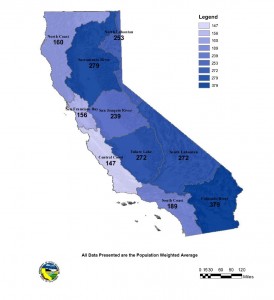Some months ago, I complained in the newspaper about water consumption in Palm Springs:
Today … customers of the Desert Water Agency, which serves Palm Springs, consume an average of 540 gallons of water per person per day.
Having just visited Palm Springs on a desert vacation, I had that number in mind last week when the Albuquerque Bernalillo County Water Utility Authority released its latest per capita calculations. They show that water usage in the Albuquerque area in 2011 dropped below 150 gallons per person per day, down from 252 gallons when water conservation efforts began in the mid-1990s.
I stand corrected. A new report compiled by California’s Department of Water Resources (pdf) puts the Desert Water Agency’s consumption at 736 gallons per person per day. Here in Albuquerque, we’re at 150. Compare that to, say, Sydney, Australia, which is down to 83.
The Desert Water Agency number is part of the first phase of California’s “20 by 20“, an attempt to get water agencies to cut per capita use 20 percent by 2020. I’m guessing the Desert Water Agency isn’t going to have to break much of a sweat to get down to 589 gallons per person per day.
In fact, the map that breaks down the current usage numbers by region suggests there’s a lot of easy improvement possible in California’s municipal water usage. A state that’s flush enough to have vast areas of the state above 200, and even the densely populated south coast region from Los Angeles to San Diego at 189 has plenty of room to move. I realize we talk about California water with the rhetoric of a looming crisis. And there are some real problems to be sorted out. But these numbers show that California’s municipal water users have a lot of room to move.
Hat tip to ACWA for linking to the report.


After confirming a hunch via Google, your basic modern US bathtub holds about 100 gallons when completely full. That helps put the above numbers into perspective.
In that respect, the Sydney number seems very low, allowing for the fact that it incorporates any industrial usage as well. The city’s population is ~4.5m people, so industrial usage isn’t being averaged over 50m “capitas” or anything like that.
Maybe not unbelievably low, though. We (Sydney-siders) have had years of water restrictions only recently eased and it Wasn’t too painful. Community education and expectation setting, mostly.
Maybe Californians should just learn to turn the taps off and only water gardens with a hand-held hose between now and 2020.
Malcolm – I like the bathtub.
I should have cited my Sydney source, which is a paper by Ryan Cahill and Jay Lund (hope the link pastes OK -I’m mobile):
http://watershed.ucdavis.edu/pdf/Cahill_Residential%20Water%20Conservation%20in%20Australia.pdf
That was an interesting and very clear read. Thanks for posting the link.
I see now that it’s only talking about residential consumption, so the Sydney number sounds a lot more believable. And 83 gallons per day per capita was the 2000 consumption — their later estimates were in the mid-50’s. I wouldn’t be too surprised if that’s gone up a bit lately, though, as a number of (but not all) water restrictions have been eased in the past 12 – 18 months after consistently increased rainfall in the catchment areas.
Malcolm – As I read it, the 83 was all urban use, with 55 for residential use (Table 2).
Maybe Palm Springs should do some creative averaging to get a lower figure. That oughta solve a crisis. Worked for Albuquerque.
Coco –
Re Albuquerque, that’s a bold charge. Your evidence?
John,
This is great. Will post it on my Facebook page if it is ok…
I hope all is well.
Newsha
Focusing on the per capita use, so much for Kuznets curves, eh?
Best,
D
Newsha – Please do!
LA’s water use is 123 gallons a day per person. LA plans to reduce use further . . . but need capital to incentivize drought-friendly gardens etc.
Jonathan – Apples to apples comparisons in this area are maddening, but FYI in the state report I’m quoting from here, LADWP says its per capita use is 152 gallons per person per day.
Pingback: Palm Springs water piggery
Pingback: Inkstain year in review : jfleck at inkstain